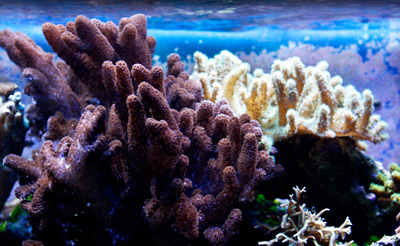Since corals and other sessile invertebrates are more or less stuck in place and can’t chase away competitors or run from predators, many of them—particularly among the soft corals—have evolved the tactic of exuding toxins into the water to prevent other inverts from encroaching and to discourage predation.
As you can imagine, this “chemical warfare,” known as allelopathy, can become problematic in closed aquaria because even the largest tank can’t remotely approximate the ocean’s capacity to dilute these noxious chemicals. Some inverts subjected to these toxins in an aquarium may be unaffected, others may remain in a contracted state, while still others may become stunted, suffer tissue necrosis, or even die as a result of the exposure.
Of course, there’s no practical way to test for these toxins and all sorts of environmental issues can cause similar problems in corals, so the challenge from the hobbyist’s standpoint is determining when issues with invertebrate livestock might be attributable to allelopathy versus water quality or some other environmental problem (e.g. inappropriate lighting or current).
Here are some signs that might indicate allelopathy is to blame:
Your tank contains a lively mix of soft and stony corals
In the typical “coral garden” tank stuffed with all different kinds of soft and stony corals, it’s not so much a question of whether allelopathy is going on but to what degree it’s going on. In this setting and assuming water parameters and other environmental factors check out okay, “chemical warfare” is often the best explanation for the odd coral refusing to open up for prolonged periods or the occasional inexplicable death or necrosis of specimens.
Your tank contains species known to be toxic
Some corals are just notorious for creating allelopathy issues. For instance, among the soft corals, various Sarcophyton, Lobophytum, Sinularia, and Lemnalia species are well known for their toxic tendencies. When you’re researching invertebrate livestock, keep in mind that a species’ proclivity for allelopathy is just as important a concern as its growth habit and husbandry requirements.
The problem starts with a new arrival
If your system is happily humming along, with all the specimens fully extended and evidently in good health, but then you suddenly experience problems after introducing a new invertebrate, odds are the newcomer is, to grossly misquote Bull Durham, “announcing its chemical presence with authority.”
It can also be the case that the new arrival is not particularly toxic but the established specimens are, in which case the newcomer may be the only one that exhibits symptoms.
Only certain specimens are affected
This one can be a bit tricky because some invertebrates are simply hardier and more adaptable than others so you can have a situation in which poor water quality or improper lighting/current affects some specimens more so than others. But generally speaking, a broader environmental problem—such as an ammonia spike—will tend to impact all or most of the livestock to one degree or another.
With allelopathy, on the other hand, the specimens doing the poisoning may look just fine while others may be affected to varying degrees (or not at all) depending on their relative constitutions and factors such as your water-change regimen, protein skimming, etc.
What have I forgotten?
No doubt I’ve overlooked other signs that allelopathy—rather than poor water quality or another environmental problem—is causing problems with reef invertebrates. If you can think of an additional point, please feel free to share it in the comment section below.



